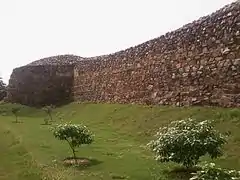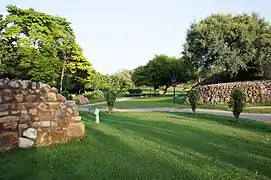Anangpal Tomar
Anangpal II, popularly known as Anangpal Tomar was an Indian king who belonged to the Tomar Dynasty. He is credited to have established and populated Delhi during his reign in the 11th century. [1]
| Anangpal Tomar II | |
|---|---|
| Maharaja of Dhillikapuri (Delhi) | |
 Lal Kot - The fortress built by Anangpal II | |
| 16th Maharaja of the Tomar Kingdom | |
| Reign | c.1051 - c.1081 CE |
| Predecessor | Kumarpala |
| Successor | Tejpala |
| Dynasty | Tomara dynasty |
| Religion | Hinduism |
He is often misunderstood to be Anangpal I - The king who established the Tomar Dynasty of Delhi in the 8th century with his capital at Anangpur. [2]
Ancestry
The Tomars are believed to be descendants of the Pandav Arjun through his grandson Parikshit.[3]
Territory
The Tomar Kingdom during the reign of Anangpal II extended over various parts of Delhi, Haryana, Punjab, Himachal Pradesh, Uttar Pradesh, Madhya Pradesh and Rajasthan.[4]
The capital of Tomars changed many times from being initially at Anangpur during the reign of Anangpal I to finally Dhillikapuri (Delhi) during the reign of Anangpal II. He is credited to have repopulated Delhi after it remained vacant for centuries.[5]
Other parts of the Kingdom which were of political importance were - Sthaneshwar(Thanesar), Asigarh(Hansi), Nagarkot(Kangra), Tanwarhinda(Bhatinda), Mihirawali(Mehrauli), Yoginipura, Mahipalpur, Mathura, Tanwarawati, Tanwarghaar, TungPatan (Patan), Gopachal(Gwalior).[6]
Constructions by Anangpal II

The Lal Kot (as the Qila Rai Pithora was originally called) is believed to be constructed in the reign of Tomar king Anangpal II. He brought the iron pillar from some unknown location (possibly mathura) and got it fixed in Delhi in the year 1052 as evident from the inscriptions on it. By assuming the iron pillar as center, numerous palaces and temples were built and finally the fort Lal Kot was built around them. The construction of the Lal Kot finished in the year 1060. The circumference of the fort was more than 2 miles and the walls of the fort were 60 feet long and 30 feet thick.[7]
Lal Kot was Delhi’s original ‘red fort’. What we call Red Fort or Lal Qila today was originally called Qila-e-Mubarak.[8]
He is also credited to have built the Anangtal Baoli in Mehrauli which is the oldest existing primitive form of Baoli in delhi.[9]
One of his son Surajpal is credited to have built the Surajkund where an yearly Mela (Fair) is held.[10]
Legacy
According to farishta, in Northern India, there existed a group of almost 150 kingdoms whose rulers considered the Tomar kings of Delhi their Chief. This group of kings is believed to have existed during the reign of Anangpal II as well. The rulers of these kingdoms only later on participated in the 1st and 2nd Battle of Tarain under the leadership of Tomar king Chahadpal Tomar ( better known as Govind Rai) who was the cousion and commander in chief of Prithviraj Chauhan.[11]
References
- Tomars of Delhi by Harihar Niwas Dwivedi. Gwalior: Vidya Mandir Publications. 1983. p. 236.
- Tomars of Delhi by Harihar Niwas Dwivedi. Gwalior: Vidya Mandir Publications. 1983. p. 236.
- Tomars of Delhi by Harihar Niwas Dwivedi. Gwalior: Vidya Mandir Publication. 1983. p. 188.
- Tomars of Delhi by Harihar Niwas Dwivedi. Gwalior: Vidya Mandir Publications. 1983.
- Tomars of Delhi by Harihar Niwas Dwivedi. Gwalior: Vidya Mandir Publications. 1983.
- Tomars of Delhi by Harihar Niwas Dwivedi. Gwalior: Vidya Mandir Publications. 1983.
- Tomars of Delhi by Harihar Niwas Dwivedi. Gwalior: Vidyamandir Publications. 1983. pp. 238–239.
- "The cities of Delhi: From the legend of Indraprastha to Qila Rai Pithora". Hindustan Times. 22 January 2018. Retrieved 24 January 2021.
- Tomars of Delhi by Harihar Niwas Dwivedi. Gwalior: Vidyamandir Publications. 1983. pp. 238–239.
- Tomars of Delhi by Harihar Niwas Dwivedi. Gwalior: Vidyamandir Publications. 1983. pp. 238–239.
- Tomars of Delhi by Harihar Niwas Dwivedi. Gwalior: Vidya Mandir Publications. 1983. pp. 283–285.